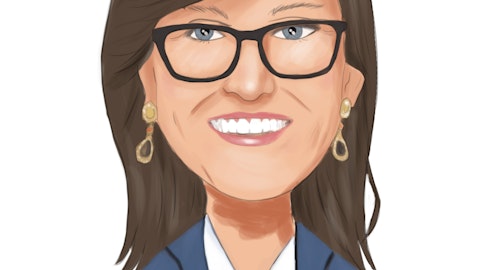James Rallo: Yes. So I think, look, the free cash flow is obviously going to come after we get to adjusted EBITDA positive. So I think that’s going to put that out a little further. We never really gave a date on that to begin with. So look, I would expect that to follow shortly after we’re adjusted EBITDA positive, but that’s going to be a quarter or two probably after that.
Matthew Hedberg: Got it. Thanks a lot guys.
Operator: Thank you. Please stand by for our next question. Our next question comes from the line of Greg Palm with Craig-Hallum. Your line is open.
Greg Palm: Yeah, good morning. Thanks for taking the question. I just want to go back to the implied outlook for Q1 in terms of active buyers versus revenue per buyer, does the implied lower revenue per buyer that you talked about, I just want to make sure we’re clear, is that solely due to a lower number of larger orders and not a broader moderation in pricing overall? And then for the full year, guide, does that take into account sort of a flat or stable revenue per buyer that is implied in Q1? Or does it assume some improvement in that metric throughout the year?
Randy Altschuler: So to be clear, we are not — at this point with our guidance, we are not baking in an improvement. Again, we’re less than two months in the year. We’re trying to be prudent here. We are being prudent here, and so we just want to set that expectation. So it doesn’t make an improvement in that. We also have said February is better than January. But January was certainly not where we were wanted it to be, particularly because of those larger orders, and that had an impact. I would tell you it is not a broader trade down. We’re not seeing a deflationary prices, et cetera. It really is about the larger orders, but we’ve been growing our number of accounts. We had a record number of additions of accounts more than $50,000 spend in Q4.
We added, I think, 103 accounts, which is — 108 — which is a record for us. So those accounts are becoming a bigger percentage of our revenue, and those are significant. So we’re excited about that. And long term, that’s going to help fuel growth and profitability. But in January, when people held back on their budgets that hurt us.
Greg Palm: Yes. Okay. And then if I could just compare the Q1 outlook to your Q3 ’23 numbers. I mean, you’re guiding revenue basically flat or same levels as Q3 ’23, but EBITDA loss, almost twice is worse. And so when you think about sort of that bridge is the majority or most of that or maybe entirely due to higher OpEx within that? Is it a lot of it more on the advertising side? Or maybe you can help tie that out.
Shawn Milne: Yeah, I mean, if you go back to Q3 and you look to where we are in Q1, I mean there’s a couple — it really is on the operating expense line. One, we’ve made investments in our sales team. We talked about that on the call. We continue to add to that team to fuel enterprise efforts. And then secondly, we continue to invest internationally. We saw very strong growth towards the end of the year internationally. We want to continue to fuel that. That should be really strong growth for us in the next couple of years. And then the third thing, Greg, is just like I think all public companies, we see a bit of a step-up from late Q4 into Q1 in terms of people costs and payroll taxes and benefits and things like that, which is which is somewhat material given the size of the business right now.
Greg Palm: Yeah, understand. Okay. I will leave it there. Thanks.
Operator: Thank you. Please stand by for our next question. Our next question comes from the line of Kunal Madhukar with UBS. Your line is open.
Unidentified Analyst: Hi. Thanks a lot. This is Jason on for Kunal from UBS. I have a couple of questions. So the first one, in terms of your 2024 Marketplace guidance, could you please unpack your at least 20% growth outlook for Marketplace revenue? And help us understand what you guys are assuming in terms of customer growth and pricing? Also, could you comment on how much of the 2024 revenue guidance is from the new verticals you guys recently added, leveraging Thomasnet? And then I have a follow-up.
Shawn Milne: It’s Shawn, I’ll take that. Randy talked about, we expect our active buyer growth to remain very healthy in 2024. We expect the active buyer of the net add number to improve from Q4 into Q1 as we resumed our marketing investments. So you should expect good strong growth in active buyers. And then as we talked about after a week January, which does impact your revenue per buyer, that’s what we’re baking in for the rest of the year, is that kind of lower rate there. So I think that’s — those are sort of the building blocks for that 20% anchor that we talked about. And then what was your follow-up question?
Unidentified Analyst: How much of 2024 revenue is from the new verticals, leveraging Thomasnet?
Shawn Milne: Yes. Look, I mean, we have a lot of initiatives in place to expand the marketplace menu. As you talked about, we’re continuing trying to add new categories from Thomas. We, of course, have the new partnership with Google. As Randy mentioned, we’re deep in work with Google now, and we expect that to expand into accelerate the deployment of new categories later in the year. Those are efforts to drive revenue per buyer, but the — as we stand here today, our forecast for the year is based on the trends we saw through January and early February.
Unidentified Analyst: Got it. For the second question. So regarding your comment on softer January orders, I was curious if you could help us understand which specific verticals that drove the decline in large orders? Thank you.
Shawn Milne: Yes. It really wasn’t in any specific vertical or geography was more widespread. It was — as Randy talked about larger customers who typically place the larger orders there was more of a pause, and we think that they’re — they’ve held back on their budgets, but we felt it was prudent today to not bake in an improvement, and that’s where we’re at.
Unidentified Analyst: Thank you.
Operator: Thank you. I’m showing no further questions in the queue. Ladies and gentlemen, that concludes today’s conference call. Thank you for your participation. You may now disconnect.
Follow Xometry Inc. (NASDAQ:XMTR)
Follow Xometry Inc. (NASDAQ:XMTR)
Receive real-time insider trading and news alerts




